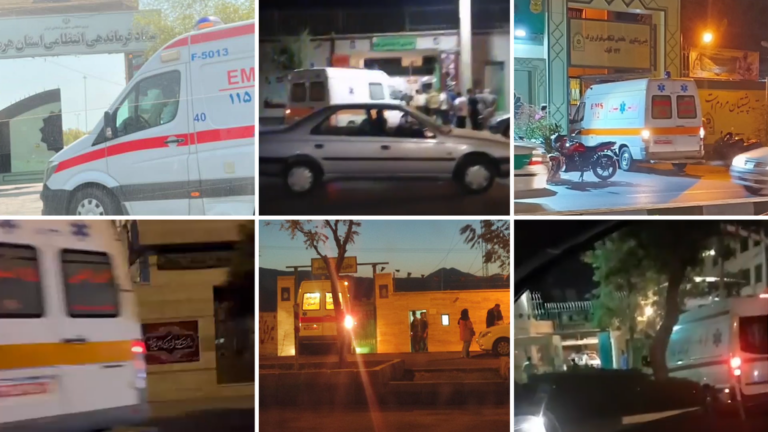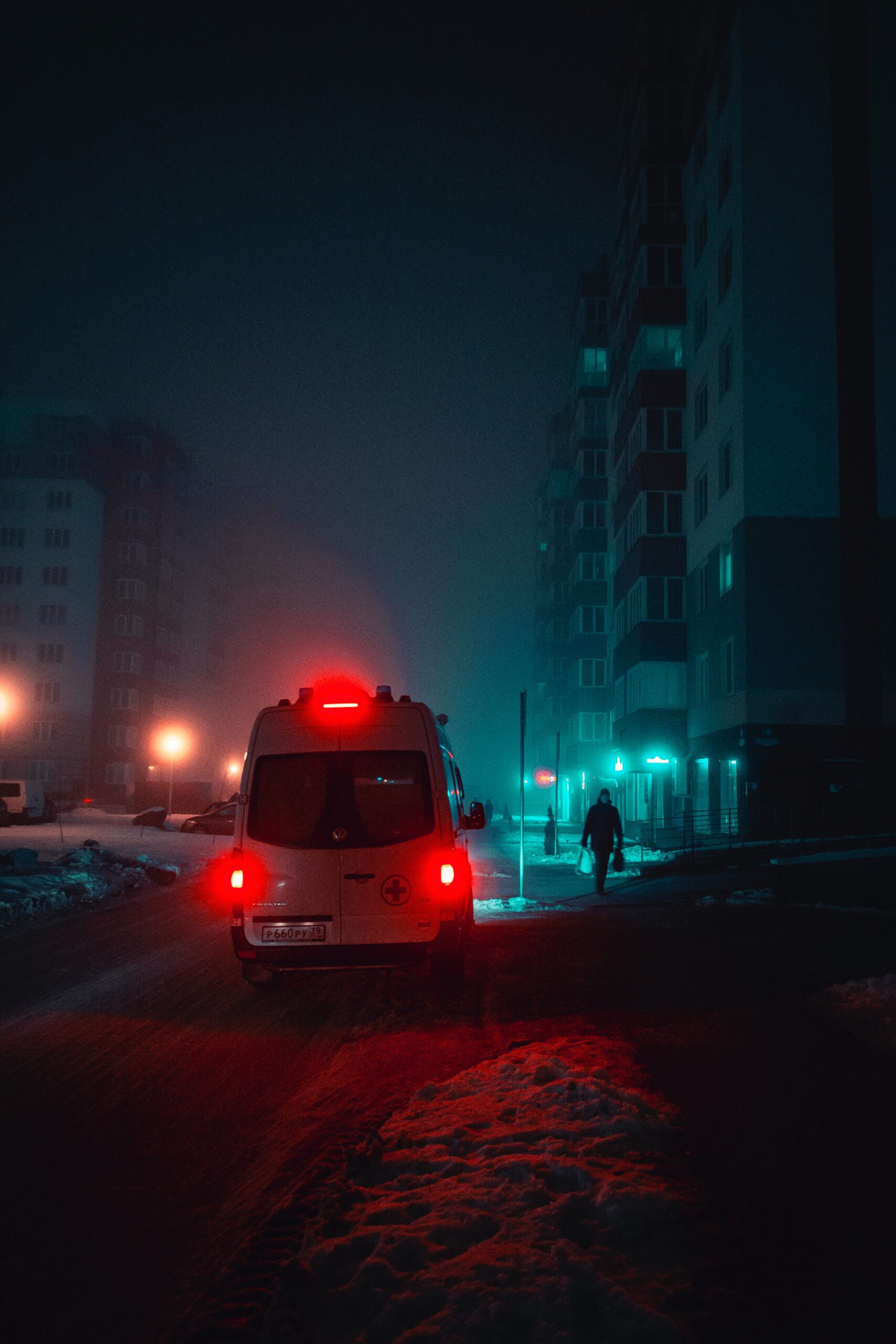Ambulance misuse by Iranian authorities-2022
How Iranian governmental forces use emergency vehicles against the protests

In most countries of the world, ambulances and other emergency vehicles have priority for immediate passage on the streets. The goal is to transfer injured patients to hospitals as quickly and safely as possible. Any other use of ambulances leads to public distrust of the healthcare system, delay the delivery of medical services to patients, and endanger patients’ health.

There are several indications that the Islamic Republic’s regime is misusing ambulances to suppress recent protests in Iran. In fact, the governmental forces want to cover up their presence in and around manifestations by using emergency vehicles. There are considerable evidence confirming ambulance misuse by Iranian government:
- Videos which confirm that the Iranian government uses ambulances for detention and transfer of protesters. In one of the videos published on social media, we can see that the protesters are trying to rescue detainees in an ambulance [1]. In other videos and photos, we see that the ambulance enters a police station instead of going to the hospital [2,3].
- There are evidence showing that they use ambulances to transfer military forces. In a video posted on social media, we notice that the direct shots towards the population come from a white van without any ambulance or police sign [4]. We can assume, the governmental forces use the white vans without any sign to mask their presence in and around the protests.
- The videos show ambulances without any number plate or with military number plates, moving in the cities, close to protestors [5,6,7,8].
- Photos and videos of a line of ambulances moving in the city [9,10].
New York Times recently published a detailed report about ambulance illegal uses by Iranian forces [11]. To obtain more detailed information, they studied 12 films and photos from 6 different cities and spoke with some of the witnesses. Their analysis show how the governmental forces using ambulances to infiltrate demonstrations and arrest protesters.
The frequency and negative impact of these actions have led to objections and protests by Iranian physicians [12]. Even, Islamic Republic of Iran Medical Council requested an independent investigation about misusing ambulances by Government forces [13]. Furthermore, one of deputies of the Islamic Consultative Assembly of Iran, Dr. Pezeshkian, was shocked about the misuse of medical vehicles: “… I can’t believe what I saw, that they misused the ambulances …” [14]
It is not the first time the Iranian government uses emergency vehicles for military purposes. In the final judgment of International People’s Tribunal on Iran’s Atrocities of November 2019, the same kind of ambulance misuses were cited [15]:
Hossein Ronaghi, an Iranian political activist, posted a video on social media to explain how governmental forces came by ambulance to arrest him [16].
It is important to remember that, according to the Geneva Conventions, even in times of war, ambulances and other medical facilities must not be used for military purposes. Considering the fact that the current situation in Iran is only a protest of the people and not an internal or international armed war. According to Article 7 of the 1977 Additional Protocol II [17]:
- All the wounded, sick and shipwrecked, whether or not they have taken part in the armed conflict, shall be respected and protected.
- In all circumstances they shall be treated humanely and shall receive, to the fullest extent practicable and with the least possible delay, the medical care and attention required by their condition.
Human rights law applies to protect health care workers as well as medical units and facilities. Under this law the states are responsible to protect medical units and facilities in situations of civil violence or state repression. As mentioned clearly in the International Committee of the Red Cross legal factsheets, states are responsible to ensure access to health infrastructures and must take measures to protect medical units and vehicles from misuses [18, 19].
International organizations such as the Red Cross focus on seven fundamental principles as humanity, Impartiality, neutrality, and independence [20]. Military usage of ambulances is against these fundamental and basic principles. For example, medical neutrality refers to a non-interference with medical services in times of armed conflict and civil unrest. One of the requirements of medical neutrality is the protection of medical personnel, patients, facilities, and transport from attack or interference [21]. Using ambulances for nonmedical purposes is against this basic medical principle.
Any doubt about the Impartiality, neutrality, and independence of the medical system causes a climate of fear and mistrust. As a result, the injured protestors were scared to seek medical help. Many Iranian protesters wounded by the security forces are afraid to go to a hospital, because they are at risk to be arrested, as mentioned by CBC news on October 11, 2022, [22].
Impartial investigations and preventive measures of international organizations like Human Rights Organization or Red Cross can prevent these kinds of abuses.
References:
- https://twitter.com/bineghab1/status/1572282578446712832?s=61&t=lCozS0hYjQG1PQt_QfdCVw
- https://twitter.com/dw_persian/status/1597332179683418112?s=61&t=lCozS0hYjQG1PQt_QfdCVw
- https://twitter.com/iranintl/status/1595880694114582528
- https://twitter.com/karimkafer/status/1576194386819706881?s=61&t=lCozS0hYjQG1PQt_QfdCVw
- https://twitter.com/IranIntl/status/1600484668662489088
- https://ir.voanews.com/a/ambulance-iran-police-protest-/6813233.html
- https://twitter.com/1500tasvir/status/1592932730966544384
- https://twitter.com/sarbaaaazekhaak/status/1572657532799422464?s=46&t=efd8hugwvueM6W3aqy7jkw
- https://twitter.com/manotonews/status/1572177611249569794?s=46&t=efd8hugwvueM6W3aqy7jkw
- https://factnameh.com/fa/fact-checks/2022-09-23-iran-police-use-ambulance-against-protests
- How Iran’s Security Forces Use Ambulances to Suppress Protests https://www.nytimes.com/2022/11/23/world/middleeast/iran-protesters-detained- ambulance.html
- https://www.radiofarda.com/a/ambulance-protests-iran/32060490.html
- https://www.farsnews.ir/news/14010730000163/بیانیه-سازمان-نظام-پزشکی-پیرامون-اقدامات-انجام-شده-در-حوادث-اخیر
- https://titre24.ir/Url/?A9wdfcmVt5BMAREHDIr0ZqFlA4YCfEb1BM7999xgJ9WC1aSLPHxFp5ewJbGJgntgPzlBujChE98=
- https://www.icty.org/x/cases/tadic/acdec/en/51002.htm
- https://twitter.com/masoudkazemi81/status/1573063149607129088?ref_src=twsrc%5Etfw%7Ctwcamp%5Etweetembed%7Ctwterm%5E1573063149607129088%7Ctwgr%5E65e1a69da2dd545851524de6a5ef9dbef9eb4cdb%7Ctwcon%5Es1_&ref_url=https%3A%2F%2Firanwire.com%2Fen%2Fpolitics%2F108164-how-iranian-authorities-use-ambulances-for-arrests-and-transporting-forces%2F
- https://www.ohchr.org/fr/instruments-mechanisms/instruments/protocol-additional-geneva-conventions-12-august-1949-and-0
- A human rights approach to health care in conflict | International Review of the Red Cross (icrc.org)
- https://www.icrc.org/en/document/respecting-and-protecting-health-care-armed-conflicts-and-situations-not-covered
- https://www.icrc.org/en/document/fundamental-principles-red-cross-and-red-crescent
- https://phr.org/wp-content/uploads/2019/11/Introduction-to-Medical-Neutrality-Fact-Sheet-2013.pdf
- https://www.cbsnews.com/news/iran-news-protests-deaths-people-shot-afraid-hospital-arrest-us-doctors-help/
Address
2785 PACIFIC COAST HWY. SUITE E719 TORRANCE, CA 90505 USA
Message Us
@theiipha
Ask Us
info@iipha.org
Inform Us
secure@iipha.org
